2018 MERCEDES-BENZ SLC ROADSTER ESP
[x] Cancel search: ESPPage 34 of 298
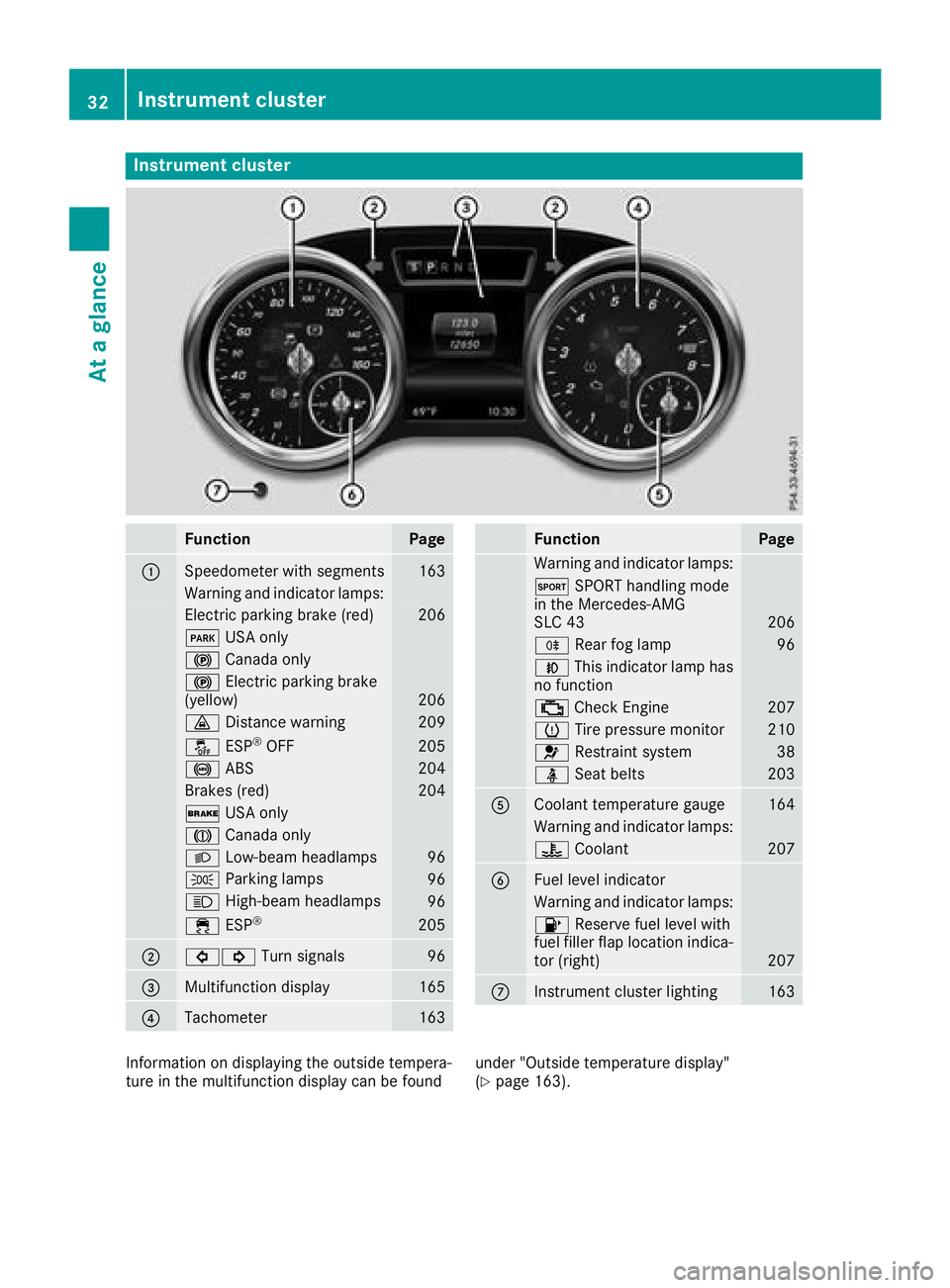
Instrumentcluster
FunctionPag e
:Speedometer wit hsegments163
Warning and indicator lamps:
Electric parking brak e(red)20 6
F USAo nly
! Canad aonly
! Electric parking brak e
(yellow)20 6
· Distanc ewarning209
å ESP®OF F205
! ABS204
Brake s(red)20 4
$ USAo nly
J Canad aonly
L Low-beam headlamps96
TParking lamp s96
KHigh-beam headlamps96
÷ESP®20 5
;#! Turn signals96
=Multifunction display165
?Tachometer163
FunctionPag e
Warning and indicator lamps:
M SPORT handlin gmode
in th eMercedes-AM G
SL C4 3
206
R Rear fog lamp96
NThis indicator lamp has
no function
; CheckEngine20 7
h Tirep ressur emonitor210
6 Restrain tsystem38
ü Seat belt s203
ACoolan ttem perature gauge164
Warning and indicator lamps:
? Coolan t207
BFue llevel indicator
Warning and indicator lamps:
8 Reserve fuel level wit h
fuel filler flap location indica-
to r( right )
207
CInstrumen tcluste rlighting16 3
Information on displayin gthe outside tempera-
tur eint hemultifunction display can be foun dunder "Outside temperature display"
(Ypage 163).
32Instrumen
tcluster
At ag lance
Page 36 of 298
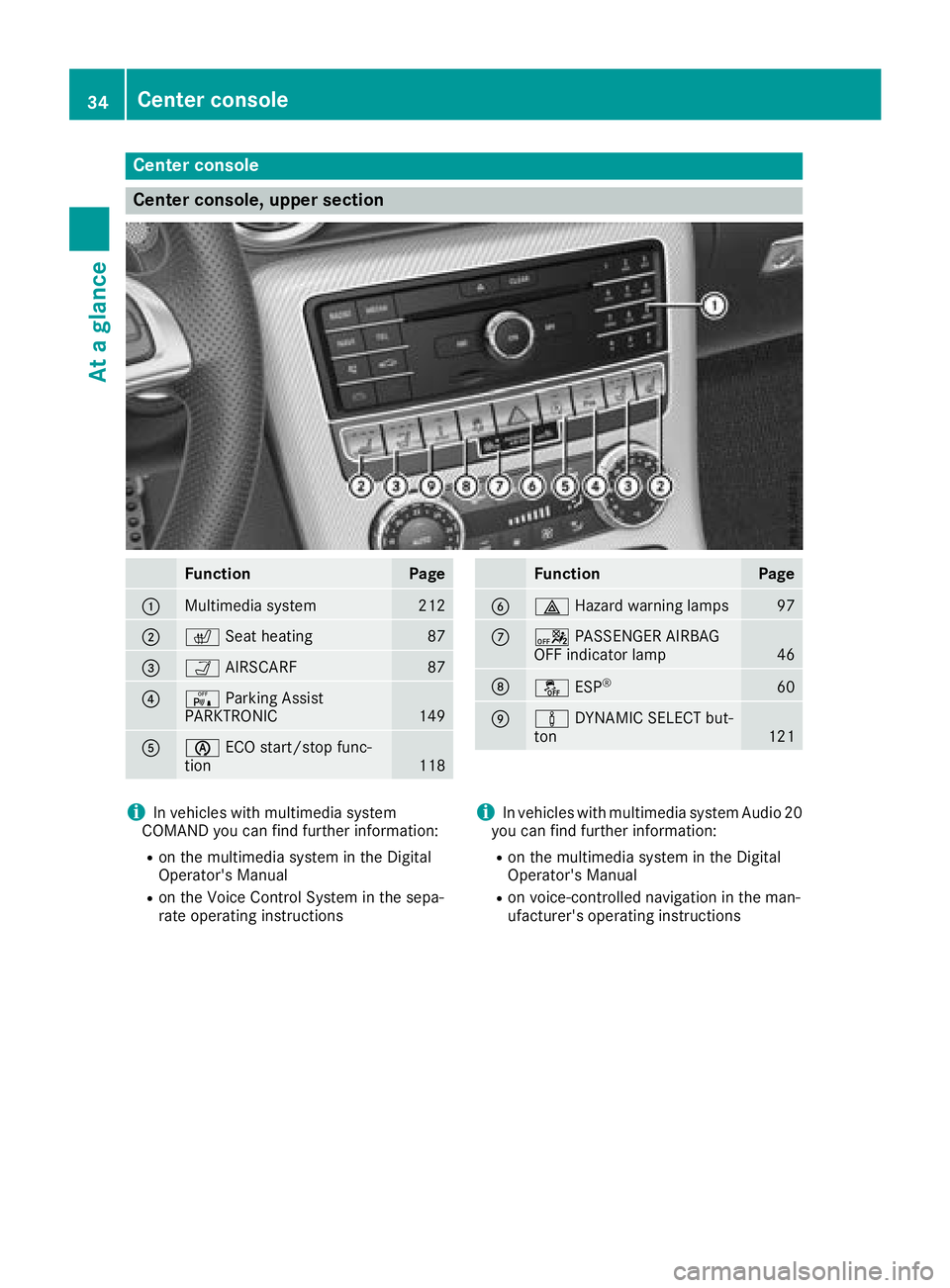
Center console
Center console, upper section
FunctionPage
:Multimedia system212
;cSeat heating87
=ÒAIRSCARF87
?cParking Assist
PARKTRONIC149
Aè ECO start/sto pfunc-
tion118
FunctionPage
B£ Hazard warning lamps97
CaPASSENGER AIRBAG
OFFi ndicator lamp46
Då ESP®60
EàDYNAMIC SELECT but-
ton121
iIn vehicle swithm ultimedia system
COMAND you can fin dfurther information:
Ron th emultimedia system in th eDigital
Operator's Manual
Ron th eVoiceC ontrol Syste minthesepa-
rat eo peratin ginstructions
iIn vehicle swithm ultimedia system Audi o20
you can fin dfurther information:
Ron th emultimedia system in th eDigital
Operator's Manual
Ron voice-controlled navigation in th eman-
ufacturer'so peratinginstructions
34Center console
At ag lance
Page 47 of 298

could be adverselyaffected. Thisposes an
increase driskofi njury or evenf atalinjury.
You shoul donly us eseatc overst hat have
bee napproved for the respectiv eseatb y
Mercedes-Benz.
Sid eimpact ai rbags: deploy next to the outer
bolster of the seatb ackrest.
Whend eployed, the sid eimpact ai rbag offers
additiona lthoraxp rotection. However, it does
not protect the:
RHead
RNeck
RArms
If the restraint system control uni tdetects aside
impact, the sid eimpact ai rbag is deployed on
the sid eonwhich the impact occurs.
The sid eimpact ai rbag on the front-passenger
sid ed eploy sunder the following conditions:
Rthe OCS system detects that the front-
passenger seati soccupied or
Rthe seatb eltb uckle tongueise ngaged in the
bel tbuckle of the front-passenger seat
If the bel ttongueise ngaged in the bel tbuckle,
the sid eimpact ai rbag on the front-passenger
sid ed eploy sifana ppropriate accident situation
occurs. In this case ,deployment is independent
of whether the front-passenger seati soccupied
or not.
Head air bags
Headb ags: deploy in the are aofthe sid ewin-
dow satt he front.
Whend eployed, the headb agenhances the
level of protectio nfor the head. However, it does
not protect the:
Rchest
Rarms
If the restraint system control uni tdetects aside
impact, the headb agis deployed on the sid eon
which the impact occurs.
If the system determine sthat they can offer
additiona lprotectio ntothat provided by the
seatb elt,aheadb agmay be deployed in other
accident situations (
Ypage 50).
The headb agon the front-passenger side
deploy sunder the following conditions:
Rthe OCS system detects that the front-
passenger seati soccupied or
Rthe seatb eltb uckle tongueise ngaged in the
bel tbuckle of the front-passenger seat
If the bel ttongueise ngaged in the bel tbuckle,
the headb agon the front-passenger side
deploy sifana ppropriate accident situation
occurs. In this case ,deployment is independent
of whether the front-passenger seati soccupied
or not.
Occupan tClassificationS ystem
(OCS)
Introduction
The Occupant Classification System (OCS) cat-
egorize sthe person in the front-passenger seat.
Depending on that result, the front-passenger
front ai rbag and front-passenger knee baga re
either enabled or deactivated.
Occupan tsafety45
Safety
Z
Page 49 of 298
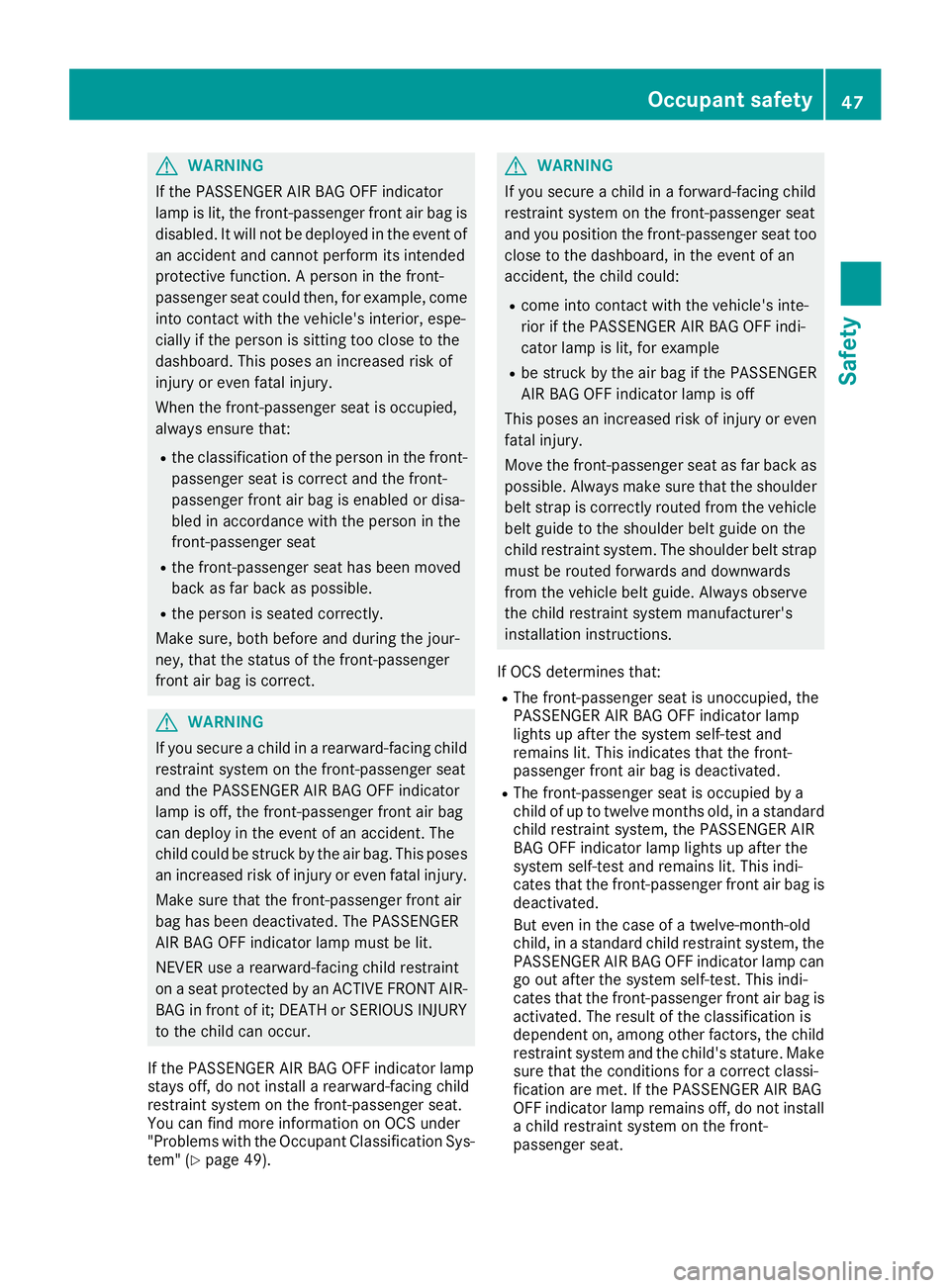
GWARNING
If the PASSENGER AIR BAG OFF indicator
lamp is lit, the front-passenge rfront air bag is
disabled. It wil lnot be deploye dinthe event of
an accident and cannot perform its intended
protective function. Apersonint he front-
passenger seat coul dthen, for example, come
into contact with the vehicle's interior, espe-
cially if the personiss itting too close to the
dashboard. This posesani ncreased risk of
injury or even fatal injury.
When the front-passenge rseat is occupied,
alway sensure that:
Rthe classification of the personint he front-
passenger seat is correct and the front-
passenger front air bag is enabled or disa-
bledina ccordance with the personint he
front-passenge rseat
Rthe front-passenge rseat has been moved
back as far back as possible.
Rthe personiss eated correctly.
Make sure ,both before and during the jour-
ney, that the status of the front-passenger
front air bag is correct.
GWARNING
If you secure achild in arearward-facing child
restraint system on the front-passenge rseat
and the PASSENGER AIR BAG OFF indicator
lamp is off, the front-passenge rfront air bag
can deploy in the event of an accident. The
child coul dbestruck by the air bag .This poses
an increased risk of injury or even fatal injury.
Make sure that the front-passenge rfront air
bag has been deactivated. The PASSENGER
AIR BAG OFF indicator lamp must be lit.
NEVER use arearward-facing child restraint
on aseat protected by an ACTIVE FRONT AIR-
BAG in front of it; DEATH or SERIOUS INJURY
to the child can occur.
If the PASSENGER AIR BAG OFF indicator lamp
stays off, do not instal larearward-facing child
restraint system on the front-passenge rseat.
You can find more information on OCS under
"Problems with the Occupant Classification Sys-
tem" (
Ypage4 9).
GWARNING
If you secure achild in aforward-facing child
restraint system on the front-passenge rseat
and you position the front-passenge rseat too
close to the dashboard, in the event of an
accident, the child could:
Rcome into contact with the vehicle's inte-
rior if the PASSENGER AIR BAG OFF indi-
cator lamp is lit, for example
Rbe struck by the air bag if the PASSENGER
AIR BAG OFF indicator lamp is off
This poses an increased risk of injury or even fatal injury.
Move the front-passenge rseat as far back as
possible.A lways make sure that the shoulder
belts trap is correctly routed from the vehicle
beltg uide to the shoulderb eltguide on the
child restraint system. The shoulderb eltstrap
must be routed forwards and downwards
from the vehicleb eltguide. Always observe
the child restraint system manufacturer's
installation instructions.
If OCS determines that:
RThe front-passenge rseat is unoccupied,t he
PASSENGER AIR BAG OFF indicator lamp
lights up after the system self-test and
remains lit. This indicates that the front-
passenger front air bag is deactivated.
RThe front-passenge rseat is occupied by a
child of up to twelve months old, in astandard
child restraint system, the PASSENGER AIR
BAG OFF indicator lamp lights up after the
system self-test and remains lit. This indi-
cates that the front-passenge rfront air bag is
deactivated.
But even in the case of atwelve-month-old
child ,inas tandard child restraint system, the
PASSENGER AIR BAG OFF indicator lamp can
go out after the system self-test. This indi-
cates that the front-passenge rfront air bag is
activated. The result of the classification is
dependent on, among other factors, the child
restraint system and the child's stature. Make
sure that the conditions for acorrect classi-
ficatio nare met. If the PASSENGER AIR BAG
OFF indicator lamp remains off, do not install
ac hild restraint system on the front-
pa
ssenger seat.
Occupant safety47
Safety
Z
Page 50 of 298
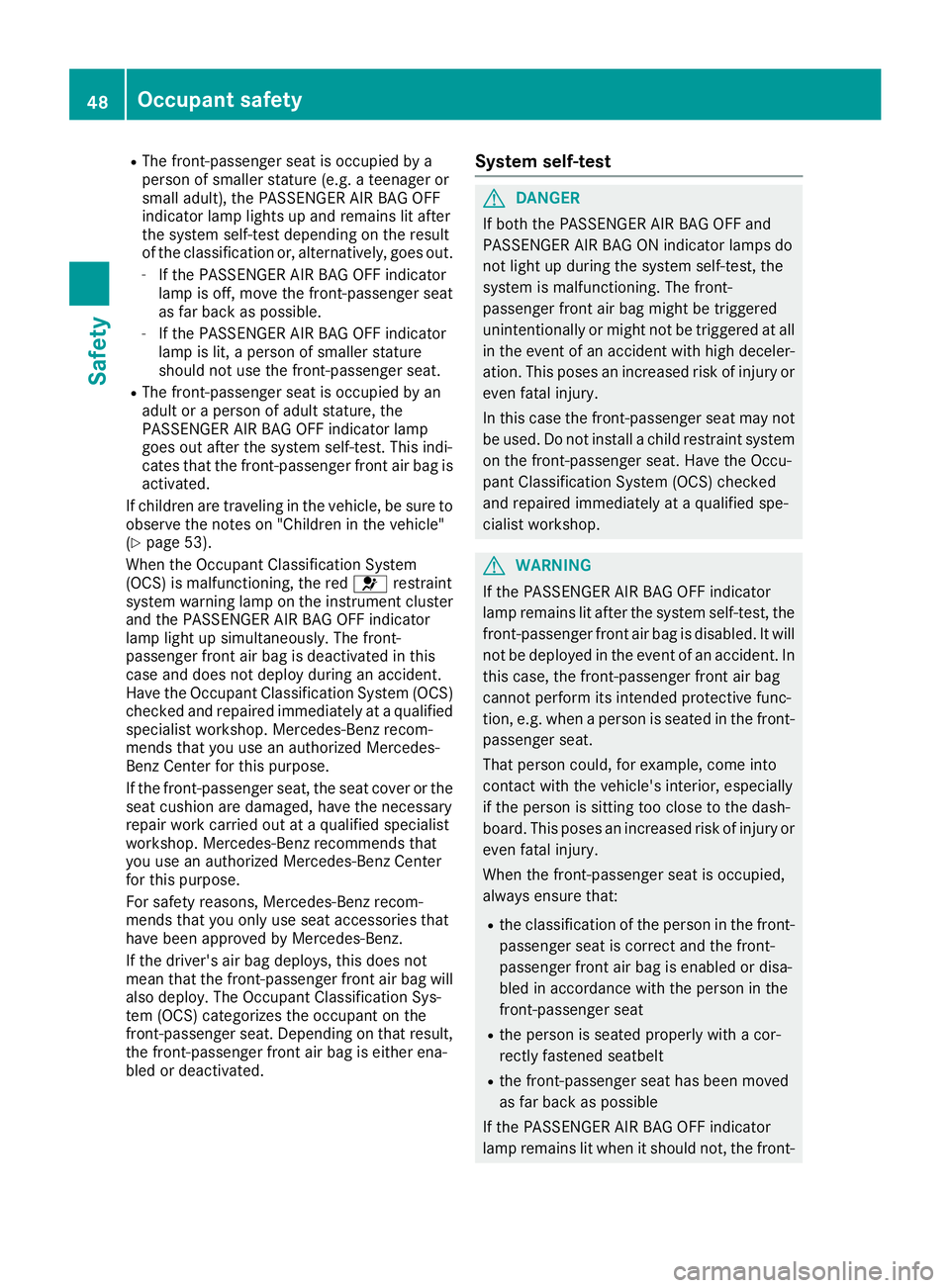
RThe front-passenger seat is occupied by a
person of smaller stature (e.g.ateenager or
small adult), the PASSENGER AIR BAG OFF
indicator lamp lights up and remains lit after
the system self-test depending on the result
of the classification or, alternatively, goes out.
-If the PASSENGER AIR BAG OFF indicator
lamp is off, move the front-passenger seat
as far back as possible.
-If the PASSENGER AIR BAG OFF indicator
lamp is lit, aperson of smaller stature
should not use the front-passenger seat.
RThe front-passenger seat is occupied by an
adult or aperson of adult stature, the
PASSENGER AIR BAG OFF indicator lamp
goes out after the system self-test. This indi-
cates that the front-passenger front air bag is
activated.
If children are traveling in the vehicle, be sure to observe the notes on "Children in the vehicle"
(
Ypage 53).
When the Occupant Classification System
(OCS) is malfunctioning, the red 6restraint
system warning lamp on the instrument cluster
and the PASSENGER AIR BAG OFF indicator
lamp light up simultaneously. The front-
passenger front air bag is deactivated in this
case and does not deploy during an accident.
Have the Occupant Classification System (OCS)
checked and repaired immediately at aqualified
specialist workshop. Mercedes-Benz recom-
mends that you use an authorized Mercedes-
Benz Center for this purpose.
If the front-passenger seat, the seat cover or the seat cushion are damaged, have the necessary
repair work carried out at aqualified specialist
workshop. Mercedes-Benz recommends that
you use an authorized Mercedes-Benz Center
for this purpose.
For safety reasons, Mercedes-Benz recom-
mends that you only use seat accessories that
have been approved by Mercedes-Benz.
If the driver's air bag deploys, this does not
mean that the front-passenger front air bag will
also deploy. The Occupant Classification Sys-
tem (OCS) categorizes the occupant on the
front-passenger seat. Dependin gonthat result,
the front-passenger front air bag is either ena-
bled or deactivated.
System self-test
GDANGER
If both the PASSENGER AIR BAG OFF and
PASSENGER AIR BAG ON indicator lamps do
not light up during the system self-test, the
system is malfunctioning. The front-
passenger front air bag might be triggered
unintentionally or might not be triggered at all
in the event of an accident with high deceler-
ation. This poses an increased risk of injury or
even fatal injury.
In this case the front-passenger seat may not
be used. Do not install achild restraint system
on the front-passenger seat. Have the Occu-
pant Classification System (OCS) checked
and repaired immediately at aqualified spe-
cialist workshop.
GWARNING
If the PASSENGER AIR BAG OFF indicator
lamp remains lit after the system self-test, the
front-passenger front air bag is disabled. It will
not be deployed in the event of an accident .In
this case, the front-passenger front air bag
cannot perform its intended protective func-
tion, e.g. when aperson is seated in the front-
passenger seat.
That person could, for example, come into
contact with the vehicle's interior, especially
if the person is sittin gtoo close to the dash-
board. This poses an increased risk of injury or
even fatal injury.
When the front-passenger seat is occupied,
alwayse nsure that:
Rthe classification of the person in the front-
passenger seat is correcta nd the front-
passenger front air bag is enabled or disa-
bled in accordanc ewith the person in the
front-passenger seat
Rthe person is seated properly with acor-
rectly fastened seatbelt
Rthe front-passenger seat has been moved
as far back as possible
If the PASSENGER AIR BAG OFF indicator
lamp remains lit when it should not,t he front-
48Occupant safety
Safety
Page 53 of 298
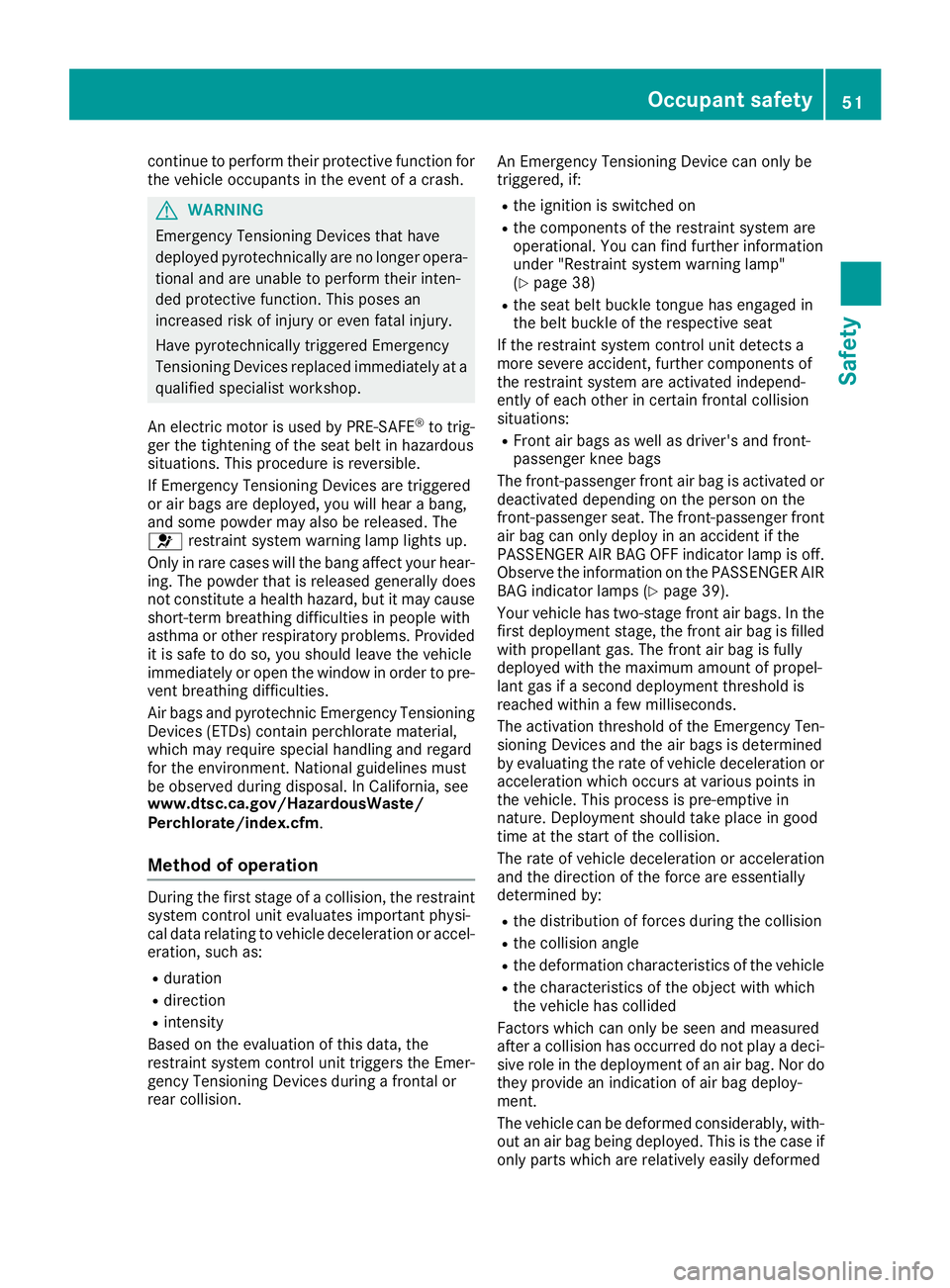
continuetoperform theirp rotective function for
the vehicle occupants in the event of acrash.
GWARNING
Emergency Tensioning Devices that have
deployed pyrotechnicall yare no longer opera-
tiona land are unabletop erform theirinten-
ded protective function. Thisp oses an
increase driskofi njury or evenf atalinjury.
Have pyrotechnicall ytriggeredE mergency
Tensioning Devices replaced immediatel yata
qualified specialist workshop.
An electri cmotor is used by PRE-SAFE
®to trig-
ger the tightening of the seatb eltinh azardous
situations. Thisp rocedure is reversible.
If Emergency Tensioning Devices are triggered
or ai rbagsa re deployed, yo uwillh earab ang,
and some powder may also be released .The
6 restraint system warning lamp lights up.
Only in rar ecase swillt he bang affect your hear-
ing. The powder that is released generally does
not constitute ahealth hazard ,but it may cause
short-term breathing difficulties in peoplew ith
asthma or otherr espiratory problems. Provided
it is saf etodos o, youshoul dleave the vehicle
immediatel yoropenthe window in order to pre-
vent breathing difficulties.
Air bags and pyrotechnic Emergency Tensioning
Devices (ETDs) contai nperchlorate material,
which may require specia lhan dling and regard
for the environment. National guidelines must
be observedd uring disposal .InCalifornia, see
www.dtsc.ca.gov/HazardousWaste/
Perchlorate/index.cfm.
Metho dofoperation
During the firs tstag eofac ollision, the restraint
system control uni tevaluates important physi-
cal data relating to vehicle deceleration or accel-
eration, such as:
Rduration
Rdirection
Rintensity
Base dont he evaluation of this data, the
restraint system control uni ttriggers the Emer-
gency Tensioning Devices during afrontalo r
rearc ollision. An Emergency Tensioning Device can only be
triggered, if:
Rthe ignition is switched on
Rthe components of the restraint system are
operational
.You can find further information
under "Restraint system warning lamp"
(
Ypage 38)
Rthe seatb eltb uckle tongueh asengaged in
the bel tbuckle of the respectiv eseat
If the restraint system control uni tdetects a
more severe accident, further components of
the restraint system are activate dindepend-
ently of each otherinc ertain frontalcollision
situations:
RFront ai rbagsasw ellasd river'sa nd front-
passenger knee bags
The front-passenger front ai rbag is activate dor
deactivated depending on the person on the
front-passenger seat. The front-passenger front
ai rb ag can only deploy in an accident if the
PASSENGER AIR BAG OFF indicator lamp is off.
Observe the information on the PASSENGER AIR
BAG indicator lamps (
Ypage 39).
You rvehicle hast wo-stage front ai rbags. In the
firs tdeployment stage, the front ai rbag is filled
with propellant gas. The front ai rbag is fully
deployed with the maximum amount of prop
el-
lant gasifas econd deployment thresholdi s
reached within afew milliseconds.
The activation thresholdoft he Emergency Ten-
sioning Devices and the ai rbagsisd etermined
by evaluating the rate of vehicle deceleration or
acceleration which occurs at variousp oints in
the vehicle .Thisp rocess is pre-emptive in
nature. Deployment shoul dtake place in good
time at the star tofthe collision.
The rate of vehicle deceleration or acceleration
and the direction of the force are essentially
determine dby:
Rthe distribution of forcesd uring the collision
Rthe collision angle
Rthe deformation characteristics of the vehicle
Rthe characteristics of the object with which
the vehicle hasc ollided
Factor swhich can only be seena nd measured
afte rac ollision haso ccurred do not play adeci-
siv eroleint he deployment of an ai rbag.N or do
they provid eanindication of ai rbag deploy-
ment.
The vehicle can be deformedc onsiderably,with-
outana irbagb eing deployed. Thisist he case if
only parts which are relativelye asilyd eformed
Occupan tsafety51
Safety
Z
Page 54 of 298
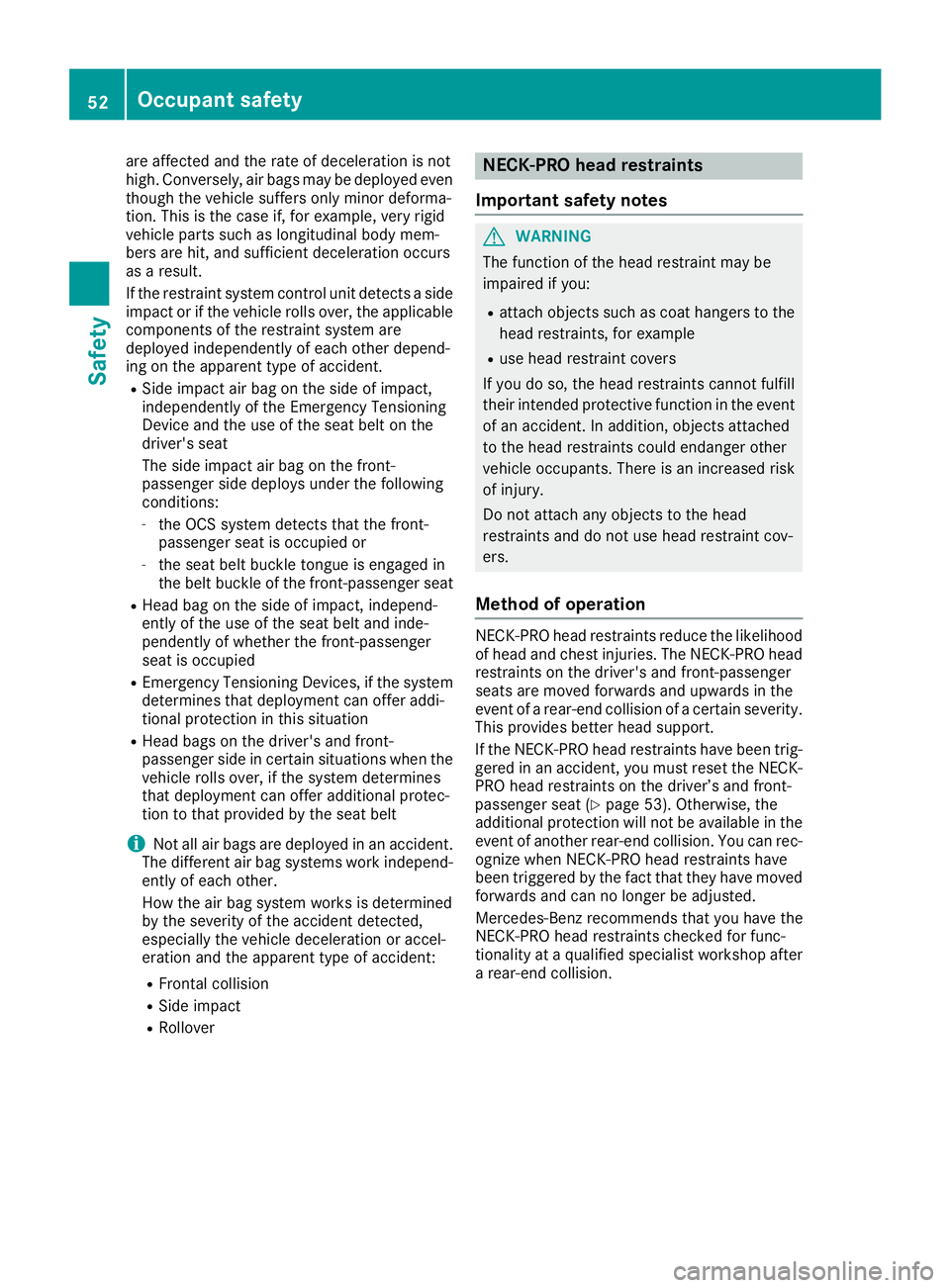
are affected and therateofd eceleratio nisnot
high.C onversely, air bags may be deployed even
though th evehicle suffers only minor deforma-
tion. This is th ecasei f, for example, ver yrigid
vehicle part ssuchasl ongitudinal body mem-
bers are hit,a nd sufficient deceleratio noccurs
as aresult.
If th erestraint system control unit detect saside
impac torift hevehicle roll sover, th eapplicable
component softherestraint system are
deployed independently of each other depend-
ing on th eapparent type of accident.
RSid eimpacta ir bag on th eside of impact,
independently of th eEme rgenc yTensioning
Devic eand th euse of th eseat belt on the
driver'ss eat
The side impac tair bag on th efront -
passenger side deploys unde rthe following
conditions:
-th eO CS system detect sthatthe front-
passenger seat is occupied or
-th es eat belt buckle tongue is engaged in
th eb elt buckle of th efront-pa ssenger seat
RHead bag on th eside of impact, independ-
ently of th euse of th eseat belt and inde-
pendently of whether th efront-pa ssenger
seat is occupied
REmergenc yTensioning Devices, if th esystem
determine sthatd eploymen tcan offer addi-
tional protection in this situation
RHead bags on th edriver'sa nd front-
passenger side in certain situations when the
vehicle roll sover, if t
h
esystem determines
that deploymen tcan offer additional protec-
tio ntot hatp rovided by th eseat belt
iNot all air bags are deployed in an accident.
The differenta ir bag systems work independ-
ently of each other.
How th eair bag system worksisd etermined
by th eseverityoft heaccidentd etected,
especially th evehicle deceleratio noraccel-
eration and th eapparent type of accident:
RFrontal collision
RSid eimpact
RRollover
NECK-PROh eadr estraints
Important safety notes
GWARNING
The function of th ehead restraint may be
impaired if you:
Rattach object ssuchasc oat hangerstot he
head restraints, for example
Ruse head restraint covers
If you do so, th ehead restraint scanno tfulfill
their intended protective function in th eevent
of an accident. In addition,o bjectsattached
to th ehead restraint scoul de ndanger other
vehicle occupants. Thereisani ncreased risk
of injury.
Do no tattach any object stothehead
restraint sand do no tuse head restraint cov-
ers.
Method of operation
NECK-PRO head restraint sreduc ethe likelihood
of head and chest injuries.T he NECK-PRO head
restraint sonthedriver'sa nd front-passenger
seatsa re moved forwards and upwards in the
eventofar ear-endcollision of acertain severity.
This provides bette rhead support.
If th eNECK-PRO head restraint shave been trig-
gered in an accident, you must reset th eNECK-
PRO head restraint sonthedriver’s and front-
passenger seat (
Ypage 53) .Otherwise, the
additional protection will no tbeavailabl einthe
eventofa nother rear-en dcollision.Y ou can rec-
ognize when NECK-PRO head restraint shave
been triggered by th efacttha tthe yh ave moved
forwards and can no longer be adjusted.
Mercedes-Ben zrecommend sthaty ou have the
NECK-PRO head restraint schecked for func-
tionalit yataq ualified specialist workshop after
ar ear-en dcollision.
52Occupant safety
Safety
Page 57 of 298

Child restraint system
The use of seat beltsand child restraint systems
is required by law in:
Rall 50 states
Rth eU .S.t erri tories
RtheD istrict of Columbia
Rall Canadian provinces
You can obtain further informatio nabout the
correc tchild restraint system from any author-
ize dM ercedes-Ben zCenter.
GWARNING
If th echild restraint system is installed incor-
rectly on asuitable seat,itc annotprotect as
intended. The child canno tthe nber estrained
in th eevent of an accident, heavyb raking or
suddenc hanges of direction.T hereisan
increased ris kofinjury, possibly eve nfatal.
Makes ure that you observ ethe child restraint
system manufacturer'si nstallationinstruc-
tions and th enotes on use. Pleasee nsure,
that th ebase of th echild restraint system is
always restin gcompletely on th eseat cush-
ion.N ever placeo bjects, e.g.cushions, under
or behindt hechild restraint system. Only use
child restraint systems witht heoriginal cover
designe dfor them. Only replace damaged
covers withg enuine covers.
GWARNING
If th echild restraint system is installed incor-
rectly or is no tsecured, it can com eloosei n
th ee vent of an accident, heavyb raking or a
suddenc hang eind irection.T he child
restraint system coul dbethrown about,s trik-
ing vehicle occupants .Thereisani ncreased
ris kofi njury, possibly eve nfatal.
Always install child restraint systems prop-
erly, eve niftheya re no tbeingu sed. Make
sure that you observ ethe child restraint sys-
te mm anufacturer'si nstallationinstructions.
Further informatio nonstowingo bjects, luggage
and loads securely can be foun dunde r“Stowi ng
options/stowage compartments”
(
Ypage 219).
GWARNING
Child restraint systems or their securin gsys-
tems whichh ave been damaged or subjected
to aload in an accidentc an no longer protect
as intended. The child canno tthe nb e
restraine dintheevent of an accident, heavy
braking or suddenc hanges of direction.T here
is an increased ris kofinjury, possibly even
fatal.
Replacec hild restraint systems whichh ave
been damaged or subjected to aload in an
accidentass oon as possible. Hav ethe secur-
ing systems on th echild restraint system
checked at aqualified specialist workshop,
before you install achild restraint system
again.
The securin gsystem of child restraint systems is
th es eat belt system.
iIf you install achild restraint system on the
front-passenger seat,bes ure to observethe
instructionsa nd safety note sonthe"Occu-
pantC lassificatio nSyste m(OCS)"
(
Ypage 45). Therey ou will also findinforma-
tio nond eactivatin gthe front-passenger front
air bag.
All child restraint systems must mee tthe fol-
lowings tandards:
RU.S. Federal Motor Vehicle SafetyS tandards
21 3a nd 225
RCanadian Motor Vehicle SafetyS tandards
21 3a nd 210.2
Confirmation that th echild restraint system cor-
responds to th estandards can be foun donan
instruction label on th echild restraint system.
This confir mation c
an also be foun
dintheinstal-
lation instructionst hata re included witht he
child restraint system.
Observ ethe warning labels in th evehicle inte-
rior and on th echild restraint system.
Child restraint system on th efront-
passengers eat
General notes
If you install achild restraint system on the
front-passenger seat,a lways observethe
Children in th evehicle55
Safety
Z